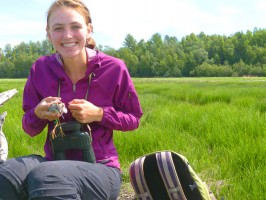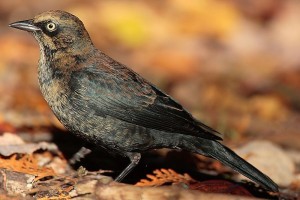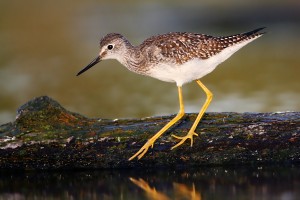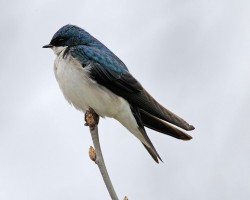Audubon Alaska partners with UAA
by Jamie Gonzales |
Tess Forstner, a junior at UAA, spent her Alaska summer dressed in Xtratufs, wading through wetlands on a quest for chicks. Boreal birds, actually. She also wrangled a couple dozen volunteers who were willing to tromp through their backyard wetlands in Anchorage and the Matanuska Valley to monitor target species-Lesser Yellowlegs, Greater Yellowlegs, Solitary Sandpipers, Rusty Blackbirds, Olive-sided Flycatchers, Tree Swallows and Violet-green Swallows. Each sighting of the highlighted species meant a 30-minute phone call for Tess from an excited birder. And she loved every minute of it.
A scholarship from Audubon Alaska and funding from UAA's Center for Community Engagement & Learning made it all possible.
"My job was the highlight of my summer!" Tess says. This was her first foray into field work and, despite the mosquitoes and pervasive "bog smell" on her clothes after a day in Potter's Marsh, she is already looking beyond her final two years as an environment and society major and on to graduate school.
"I think I want to get a Ph.D.," she says with a smile. That's the power of nature in the right hands. Working with volunteers, Audubon Alaska staff and her mentor and professor, Audrey Taylor, Tess coordinated a large monitoring effort for boreal birds across 32 wetland sites in Anchorage. She also helped Lee Tibbitts, a researcher with U.S. Geological Survey, capture and recover Lesser Yellowlegs to examine migration patterns.
A bird in the hand
"Catching birds is way cooler than I ever thought it would be," says Tess. "The first time I caught a bird, I hadn't really figured out birding yet-it's something that takes a little time to get into. If you only know five species, how exciting is that?"
But her first day out with Tibbitts and a mist net, she held a wild bird in her hands.
"It is really cool to hold something that nobody else in the world has ever held before," she says. "I caught a Lesser Yellowlegs and it was adorable. It's like holding a puppy, their little hearts are going thump-thump-thump-thump-thump."
"There's so much you can get from holding a wild animal in your hand," says Tess's mentor, Assistant Professor of Environmental Studies Audrey Taylor. "You feel like it's this disturbance to the animal, but if you are doing a good job, collecting the data you need from it, then let it go and appreciate that it just sat in your hand and gave you this data so you can hopefully understand that species better and act to promote conservation and management."
Professor Taylor has big-picture plans for their work and is looking forward to continued collaboration with Audubon Alaska and other community partners for future volunteer-staffed Citizen Science projects like Tess's.
Citizen scientists play a key role
"Lee Tibbitts has been working with Lesser Yellowlegs for years now and they're declining pretty rapidly across most of their range," says Professor Taylor. "We haven't really figured out why." Though they suspect hunting issues on wintering grounds and wetland drying, a result of climate change, might be important factors.
"We started with Lesser Yellowlegs because then we could compare some of our data now with her historical data from the 1980s and 1990s," she says. They're actively seeking funding to run the comparisons, but by launching the Citizen Science component this summer, they're getting people engaged in the project and creating a network to deploy when they receive additional grant funds.
Weary travelers
Avid birders know that many of the target species for this project are far-flung travelers who migrate between South America and Alaska.
The cool part for Tess and the volunteers was learning more about how we plotted their migration routes. Tibbitts has been outfitting Lesser Yellowlegs with light loggers that sense the quality of light and stores the data on a microchip. When they recapture an animal with a logger, they'll read the data and learn where the bird has been, give or take 100 miles.
"It has a threshold sensor. When it goes above a certain level, it calls that light, and when it falls below it, it calls that dark, so you get sunrise and sunset time," says Professor Taylor. "It also records throughout the day, the time of the most direct sunlight, and that's local noon. So based on the sunrise/sunset times and the timing of local noon, you can get latitude and longitude information.
Ultimately, Professor Taylor and Audubon Alaska would love to see interpretive signage near the bird habitats, encouraging bird watchers to report sightings of tagged birds and giving them a little more information about these long-range travelers.
Intergenerational collaboration
Everybody wins with continuing community-university partnerships, say Tess and Professor Taylor.
"We like to see this intergenerational collaboration," says Professor Taylor. Many of the birding volunteers are established older Alaskans.
"A lot of students, especially as undergrads, don't have a lot of connection to a community. You just aren't at the age where you're thinking about that," she says. "The people who work for Audubon, volunteers, are generally very invested in their communities, so you have that dual perspective that provides some continuity."
Now that Tess has gotten her feet wet this summer, both literally and figuratively, she's invested in the future of Citizen Science projects between UAA and Audubon Alaska.
"Now I probably know ten species of birds," she says with a laugh. She's officially a birder now.
 "Audubon Alaska partners with UAA" is licensed under a Creative Commons Attribution-NonCommercial 4.0 International License.
"Audubon Alaska partners with UAA" is licensed under a Creative Commons Attribution-NonCommercial 4.0 International License.













